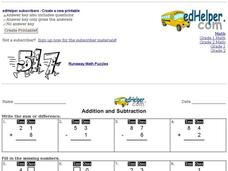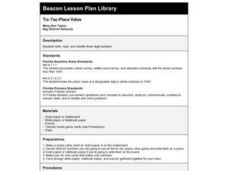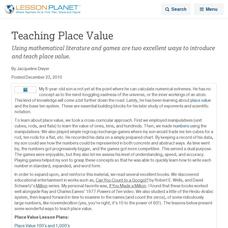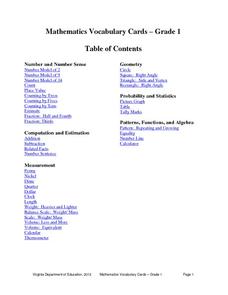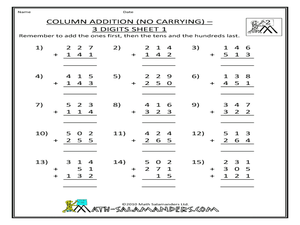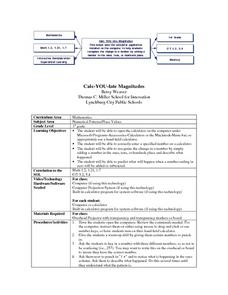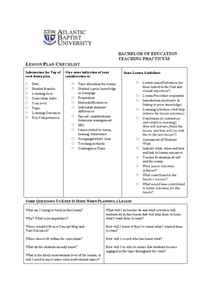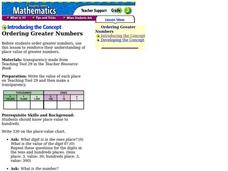EdHelper
Addition and Subtraction Using Place Value
In this addition and subtraction instructional activity, students solve simple problems where the tens and ones columns of numbers are labeled for them. Students then solve 4 word problems. Worksheet is part of a subscription site with...
Curated OER
Subtract Tens and Ones
in this finding the differences worksheet, students subtract one-digit and two-digit numbers from two-digits written in place value blocks with some regrouping. Students solve 12 problems.
Curated OER
Horizontal Addition
Here are four examples of double-digit horizontal addition. Learners are shown how to compute numbers horizontally, by first adding the tens and then the ones columns and then adding them both together. This is a great way to boost...
Curated OER
Rounding Tens to Thousands
In this rounding worksheet, students solve 20 different problems that include rounding various numbers. First, they round some numbers to the nearest hundred. Then, students round different numbers to the nearest thousand. And finally,...
Curated OER
Tic-Tac-Place Value
First graders explore how to write, read, and identify three-digit numbers.
Charleston School District
Scientific Notation and Appropriate Units
How do you write a number in scientific notation? The handout and video provide an explanation on how to convert from standard form into scientific notation and vice versa. The resource also contains a short discussion about choosing...
Curriculum Corner
Fifth Grade Summer Math Booklet
A 33-page packet focuses on fifth-grade math concepts. Learners practice rounding numbers to the hundred thousands, thousands, hundreds, tens, ones, hundredths, thousandths, and hundred thousandths. They also compare whole...
Curated OER
Expanded Notation Poster
Show how numbers can be expanded with this vivid chart expressing different place values. The chart takes four numbers and writes them with expanded notation in their thousands, hundreds, tens, and ones places.
Curated OER
Comparing Two Digit Numbers Using Symbols
Second graders compare two digit numbers. In this comparing numbers lesson, 2nd graders discover greater than and less than symbols. Students read Five Little Monkeys Sitting In A Tree and use the story as a model for comparing numbers....
Curated OER
Teaching Place Value
Utilizing mathematical literature and games are two excellent ways to introduce and teach place value.
Illustrative Mathematics
Regrouping
What number does 6 tens and 16 ones represent? How is it different from or similar to the number that 7 tens and 6 ones represent? This is the type of questions learners are asked to solve as a way to understand the concept of regrouping.
Virginia Department of Education
Mathematics Vocabulary Cards - Grade 1
Clarify basic math concepts with a series of vocabulary posters designed for first graders. The cards include illustrations for fractions, place value, tally marks, and number lines, as well as many more vocabulary words.
Math Salamanders Ltd.
Column Addition (No Carrying)—Three Digits 1
In this column, students solve 13 problems by adding three digits without carrying the worksheet. They add the ones, then the tens, and then the hundreds of columns.
Curated OER
McONE Hundredth Day
Students explore the components of a calendar and counting through the preparation and celebration of the "One Hundredth Day" of school. Badges are worn and McDonald fries are enjoyed in the celebration.
Curated OER
Calc-You-Late Magnitudes
First graders are introduced and practice using a calculator. Individually, they enter and complete simple addition and subtraction problems. After the answer is displayed, they identify the place value for ones, tens, and hundreds...
Curated OER
How Many Cards Do We Need to Display the Dates of the Month?
Students complete activities to study the concept of place value notation. In this place value lesson, students use cards for the days of the month that only number from 1 to 9. Students find a subtraction pattern to determine the amount...
Curated OER
Understanding number to 100
Students research equivalent representations of numbers using the base 10 system. In this Base 10 lesson, students examine place value, representations of numbers, and multiples of one, ten, and one-hundred.
Curated OER
Show Me the Number
Second graders develop the ability to show two-digit numbers using place value attributes in the early additive stage five. They utilize the manipulative's of sticks, rubber bands, counters, small canisters and uni-link cubes to assist...
EngageNY
Estimating Digits in a Quotient
Boiling down any division problem to a one-digit divisor problem sure makes estimation easy. The lesson shows how to estimate division problems by using place value understanding and basic arithmetic facts to simplify the division. Some...
Curated OER
Study Buddies: Adding Two-Digit Numbers
Some times a simple lesson is all you need. Here are 2 worksheets that can be used as a lesson on problem solving, addition, and partner work. The first worksheet has learners use a tens and ones charts to practice adding simple...
Curated OER
Two-Digit Subtraction With and Without Regrouping
Second graders subtract two-digit numbers. In this mathematics lesson, 2nd graders subtract both with and without regrouping. Students use manipulatives and place value mats to assist in problem solving.
Curated OER
Rounding Decimals
Fourth graders engage in a lesson that is about the concept of rounding decimals. They review place value and focus it upon the practice of rounding. Students use 10 base decimal grids or models to help make connections with the skill.
Curated OER
Who Needs Numbers?
Students identify whole numbers through the one millions place. In this place value instructional activity, students read the book The Day Without Math and use place value mats to create numbers to the millions place. Students use base...
Curated OER
Ordering Greater Numbers
Third graders identify the place value of greater numbers. In this number sense lesson, 3rd graders use a place value chart to properly write a specific number. Students read the number and use the place value map for reinforcement.
